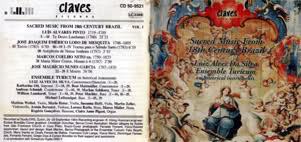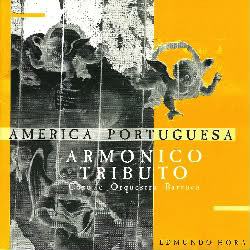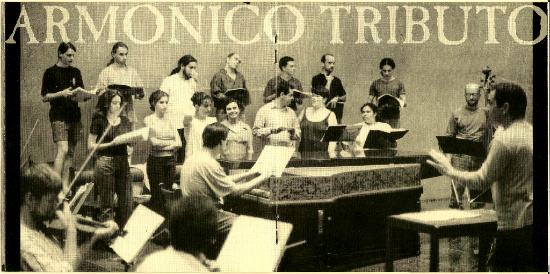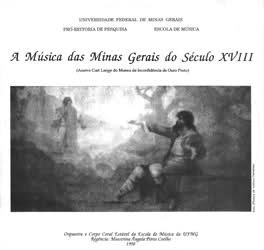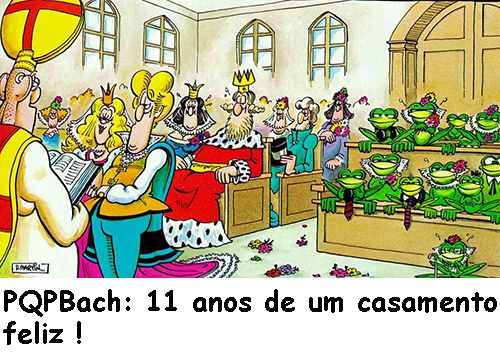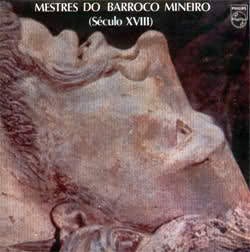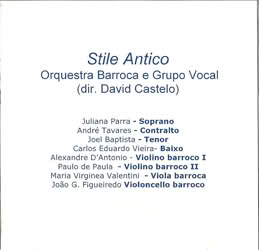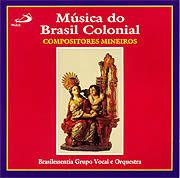Sacred Music From 18th. Century – vol. I
Ouro Preto! Black Gold! The name of one of the most beautiful cities in the world!! The fact that one must cross the Brazilian mountains and trek deep into the valley in order to reach her hidden treasures makes it even more attractive. A slave discovered gold in a stream here in the 18th century, and shortly thereafter the Portuguese streamed into the valley in search of the precious metal. Palaces, churches, fountains and villas were built here. An independent civilization arose, a combination of the European High Baroque with African and Indian influences. Aleijadinho, architect and sculptor of the stature of a Michelangelo or a Puget, left testimony of his genius in Ouro Preto, as did the painter Ataide, who employed mulattos as his models for his paintings of angels and the virgin Mary.

.
..
.
.
Music also flourished here, as demonstrated by the Schnitger Organ which was imported to Minas Gerais from Hamburg in 1752 or the opera house which was built in Ouro Preto. The city gave birth to an extraordinary wealth of music, compositions which since have fallen into almost complete neglect. The hymns, motets, masses and tedeums from this period are characterized by a special mixture of elements from Italian and Portuguese Baroque music, spiced with the unique flavor of local musical traditions. What could be more moving than the simple religious fervor of the pioneers and gold-diggers as embodied in the exquisite an of sacred song.
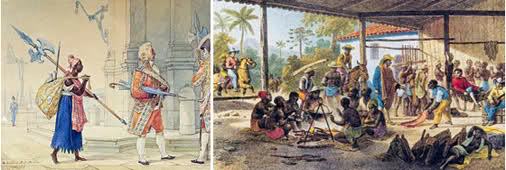
.
.
.
.
.The music from Minas Gerais is perhaps the best introduction to the mysterious and brilliant mixture of cultures that developed in the heart of Brazil. (Dominique Fernandez)
Luís Alvares Pinto was born into a mulatto family in Recife in 1719 and died there in 1789. He studied with the well-known composer Henrique da Silva Negrão in Lisbon, who introduced him to the Neapolitan style which was very popular in Portugal at the time. Given contemporary racial prejudices, it was not self-evident that a mulatto could study in the capital of the Portuguese empire. The expressive polyphony of Alvares Pinto’s Te Deum is particularly attractive, marked by the appearance of certain archaic elements (e.g., the voice-leading). The treatment of the cadences, however, presaged new esthetic ideals which would soon spread throughout Europe. Of the works on this recording, the Te Deum is the closest to the Baroque style. Only the vocal parts, a figured bass and a horn part (discovered later) remain. The latter would indicate a version for voices and small orchestra, which was reconstructed for this recording by Dr. Klaus Miehling.
José Joaquim Emerico Lobo de Mesquita is the most important representative of the so-called “Escola de Compositores da Capitania das Minas do Ouro”. Likewise a mulatto, he earned fame as an organ virtuoso and improviser. The three works on this recording by Lobo de Mesquita illustrate interesting aspects of his musical development. The Salve Regina was the first composition from the Minas school to be rediscovered. The composer goes a step further than his Neapolitan models (e.g., Pergolesi and Leo) in his employment of a four-part choir in alternation with solo voices. Tercio is one of the few compositions from Minas that has survived in full score. A surprising detail is the use of the Portuguese language in the middle of the Latin liturgical text. Tractus touches one of the focal points of the repertoire of Lobo de Mesquita and his colleagues: the music for Holy Week. The short examples recorded here are impressive not only for their theatrical dramatics, but also for the rhetorical precision in the relationship between words and music. This music is in some respects still very baroque in style, but at the same time the spirit of the classical period shines through in certain melodic turns and the style of the cadences.
Marcos Coelho Neto was born into a family of musicians in Villa Rica (today Ouro Preto) in 1750 and died there in 1823. He was a member ot the Fraternity São José dos Homens Pardos (São José was the church for the mulattos) as a horn player and composer. Very few of his works have survived, but the Himno à 4 Maria Mater Gratiæ is a little jewel. It is as if the short text is sounded in one breath. The soloists and the chorus alternate, separated by short violin interludes. The whole piece is carried by a bass line that is still strongly influenced by the basso continuo style.
When the Portuguese royalty fled from Napoleon’s troops to Brazil in 1808, the reigning crown prince Don João (son of Maria the First, “the deranged” and future Don João the Sixth) could hardly have expected to find a flourishing musical life with an artist of the stature of a José Maurício Nunes Garcia in the simple city of “São Sebastião do Rio de Janeiro”. Despite the resistance in his court, Don João did not hesitate to appoint the mulatto “Mestre da Capela Real”. The proclamation of Brazil as an empire brought Rio de Janeiro to its heights, in no small part due to foreign (mostly French) artists and musicians. Garcia reached his zenith during this golden age. The diminutive pearls recorded here represent an important part of “Padre Mestre’s” a cappella works. Two of them are dated in the manuscripts: Sepulto Domino (1789) and Judas Mercator Pessimus (1809). Although these two compositions were separated by a gap of twenty years, they are united by the similarities of their harmonic textures as well as their thematic connection to Holy Week. (Sérgio Dias)
Luis Álvares Pinto (Recife, 1719 – 1789)
01. Te Deum Laudamus (1760) 1. Te Deum/Te Dominum
02. Te Deum Laudamus (1760) 2. Te æternum/Tibi Omnes
03. Te Deum Laudamus (1760) 3. Tibi Cherubim/Sanctus
04. Te Deum Laudamus (1760) 4. Pleni sunt/Te gloriosus
05. Te Deum Laudamus (1760) 5. Te Prophetarum/Te Martirum
06. Te Deum Laudamus (1760) 6. Te per orbem/Patrem imensæ
07. Te Deum Laudamus (1760) 7. Venerandum/Sanctum quoque
08. Te Deum Laudamus (1760) 8. Tu Rex gloriæ/Tu Patris
09. Te Deum Laudamus (1760) 9. Tu ad liberandum/Tu devicto
10. Te Deum Laudamus (1760) 10. Tu ad dexteram/Judex crederis
11. Te Deum Laudamus (1760) 11. Æterna fac/Salvum fac
12. Te Deum Laudamus (1760) 12. Et rege eos/Per singulos dies
13. Te Deum Laudamus (1760) 13. Et laudamus/Dignare Domine
14. Te Deum Laudamus (1760) 14. Miserere/Fiat misericordia
José Joaquim Emerico Lobo de Mesquita (Vila do Príncipe, 1746- Rio de Janeiro, 1805)
15. Tercis (1783) – Difusa est Gratia/Padre Nosso/Ave Maria/Gloria Patri
16. Tractus para o Sábado Santo (1783) 1. Cantemus Domino
17. Tractus para o Sábado Santo (1783) 2. Vinea facta est
18. Tractus para o Sábado Santo (1783) 3. Attende cælum
19. Tractus para o Sábado Santo (1783) 4. Sicut cervulus
20. Antiphona De Nossa Senhora – Salve Regina (1787)
Marcos Coelho Neto, (Vila Rica [Ouro Preto], 1740-1806)
21. Maria Mater Gratiæ, Himno a 4 (1787)
Pe. José Maurício Nunes Garcia (1767-1830, Rio de Janeiro, RJ)
22. Motets 1. Improperium do Ofício de 6ª Feira Santa (1789) – Popule Meus
23. Motets 2. Tenuisti manum
24. Motets 3. Crux Fidelis
25. Motets 4. In Monte Oliveti
26. Motets 5. Sepulto Domino
27. Motets 6. Inter Vestibulum
28. Motets 7. Immutemur Habitu
29. Motets 8. Moteto para 5ª Feira Santa (1809) – Judas Mercator Pessimus
Sacred Music from 18th. Century Brazil – Vol. I – 1995
Ensemble Turicum, on historical instruments
Regente e diretor musical: Luiz Alves da Silva
Recorded at Studio DRS, Zurich, September 1994
.
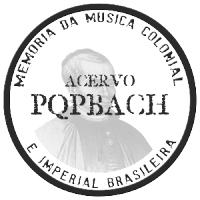 BAIXE AQUI – DOWNLOAD HERE
BAIXE AQUI – DOWNLOAD HERE
XLD RIP | FLAC 279,1 MB
BAIXE AQUI – DOWNLOAD HERE
MP3 320 kbps – 151,51 MB – 1 hora
powered by iTunes 9.0
.
.
Boa audição!
Avicenna
